
Designer and
“Joyful” author discusses how retailers can adapt in-store
environments to influence moods and affect shopping
behaviors.
Ingrid Fetell Lee’s website (www.aestheticsofjoy.com) describes her as “a designer and author whose groundbreaking work reveals the hidden influence of our surroundings on our emotions and wellbeing.” She was a design director at the global design firm IDEO, and the author of “Joyful: The Surprising Power of Ordinary Things to Create Extraordinary Happiness.” Her TED talk “Where joy hides and how to find it” has been viewed over 17 million times.
Lee has been featured as an expert by The New York Times, The Guardian, Wired, Real Simple, The Atlantic, the Today Show, HGTV Magazine, and Fast Company. She has done design and branding for Condé Nast, Eileen Fisher, American Express, Kate Spade, Diageo, Pepsico, and the U.S. government. Lee was also a founding faculty member in the Products of Design program at the School of Visual Arts in New York City.
She earned a Master’s in Industrial Design from Pratt Institute and a Bachelor’s in English and Creative Writing from Princeton University. She is known for being fond of polka dots and rainbow sprinkles. And predictably, as a purveyor of joy, she has a large repertoire of happy dances for any occasion.
The Book
“Joyful: The Surprising Power of Ordinary Things to Create Extraordinary Happiness,” published in 2018, is a field guide for those who are mindful of the transformative power of joy, a rare bird that often hides in plain sight.
Lee’s thesis is that each of her “ten aesthetics of joy,” reveals a distinct connection between the feeling of joy and the tangible qualities of the world around us.
They can be compared with the seven principles interior designers are taught to consider: rhythm, scale and proportion, balance, emphasis, contrast, harmony and unity. Although there is some overlap in terminology, Lee’s list (see graphic on the following page) looks beyond the creation of aesthetically pleasing spaces. It presents a framework for those designers, marketers and everyday people who care to create environments that trigger joyful emotions, change attitudes and, from the perspective of commerce, encourage purchases.
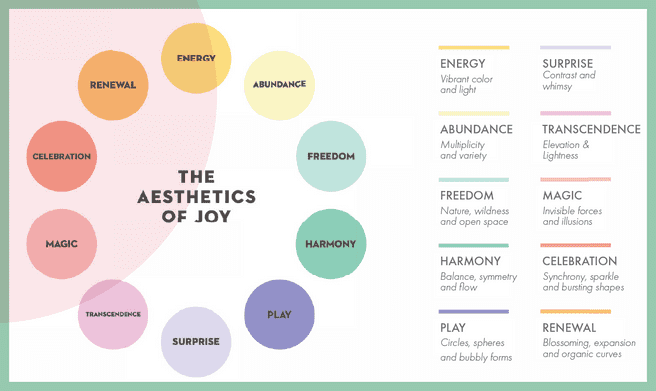
The Study of Joy
Furniture World asked Ingrid Fetell Lee if, as a person who possesses an extensive repertoire of happy dances, she was predestined to focus on the study of joy. Although she didn’t answer the question directly, Lee observed that “It was during my first year in the industrial design program at Pratt when a professor made an off-hand comment that led me to research and study joy. He said that my work gave him a feeling of joy. Previously, I thought of joy as an ephemeral feeling that comes and goes as it pleases—as something that didn’t depend on material things. A lot of us are raised to believe that material things are incidental to our happiness. Although I’ve always been attracted to beautiful things, I had internalized the belief that form follows function. Pratt challenged that judgment. It’s an aesthetics-focused school that helped me to start looking at the power of aesthetics as going far beyond just being decorative. Aesthetics can influence our well-being, our mindsets, even our behaviors.
“After graduation, while working at IDEO in the field of design research. I studied how people interact with design and how it influences them on both a physical and emotional level.”
Application to Furniture Retail
We then asked Lee if the principles of joy presented in “Joyful” might be used by home furnishings retailers and brands in predictable ways to improve their business models. She replied in the affirmative. “There’s lots of research that suggests that the experience of joy can underpin better long-term satisfaction with purchases and improve overall business results.
“Brian Tracy wrote that a large part of sales is just the transfer of enthusiasm. I love that idea because joy is part and parcel of that enthusiasm. It creates energy and excitement, a feeling that makes us happy and excited to be alive.”
The ten principles of joy described at length in “Joyful” are:
- Energy: vibrant color and light
- Abundance: lushness, multiplicity, and variety
- Freedom: nature, wildness, and open space
- Harmony: balance, symmetry, and flow
- Play: circles, spheres, and bubbly forms
- Surprise: contrast and whimsy
- Transcendence: elevation and lightness
- Magic: invisible forces and illusions
- Celebration: synchrony, sparkle, and bursting shapes
- Renewal: blossoming, expansion, and curves.
Applying any of these aesthetic principles to an in-store environment can upgrade showrooms from a monotone, closed-in and lifeless furniture experiences to something interesting, even magical.
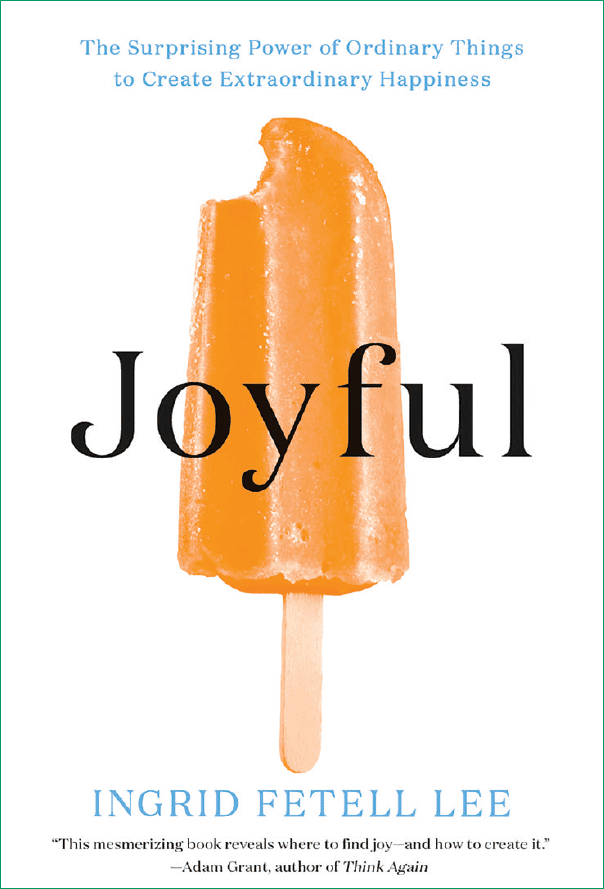
The selection of aesthetics to incorporate into a space must, of course, be curated. Lee says that is in part due to a tension between some of them.
“One example of this tension,” she explained, “is that we find joy in harmony, in things that are well ordered like a perfectly Marie Kondo’d closet. Symmetrical shapes and repeating patterns can create a feeling of order and regularity. At the same time, we can also find joy in surprise, which is the pleasurable disruption of that order. These two concepts are in tension, but they also need each other. You cannot have surprise without a background of harmony. If you have chaos everywhere then nothing will be surprising. Visualize a wall of black and white polka dots. Then imagine that just one polka dot is bright yellow. That adds the element of surprise because the regularity was already there. Aesthetics sometimes sit in tension, but they can also balance and highlight each other.”
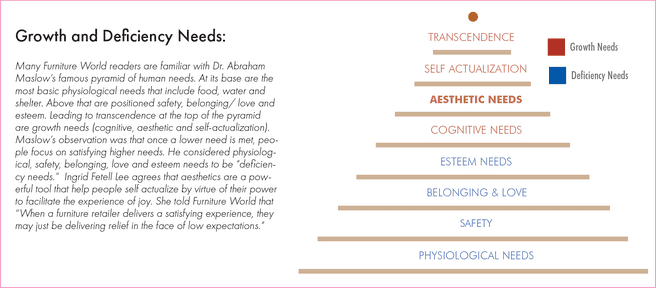
Which Aesthetics to Include
When asked if aesthetic elements can be customized for specific audiences, she explained that there are aesthetics individuals find joyful based on their personalities and life experience. “There are also aesthetics that are more culturally joyful,” she noted, “such as certain festivals or celebrations, music and food that a particular culture will find a deep resonance with.
“If a furniture retailer wants to design spaces and experiences that appeal to a large group of people, tapping into the universal aesthetics of joy is a base to build upon. If there’s a set of aesthetics preferred by a retailer’s specific audience, then the experience can be further tailored on a cultural level.
“It can be helpful to start with two to three aesthetics to focus in on and identify what kind of joyful store experience you want to create. When I work with clients, this is a major part of the process. We start with the question “How do you want people to feel?” Then we choose aesthetics that can help us do that. For example, if we want people to feel light and airy, we might choose the transcendence aesthetic, which is all about elevation, to communicate the joy most people get from being up high or on things that float and fly. Then, we choose another aesthetic to pair it with.
“If instead, we want people to feel upbeat and energetic, we would create an energy aesthetic using light and color. The aesthetics we choose tell us where to go based on how we want people to feel in a space.”

Attention
In “Joyful,” Lee references the poet Mary Oliver, who said, ‘attention is the first step toward devotion.
Disrupting the flow of our attention is the first step to catching it. It’s an important factor to consider when working with Lee’s 10 aesthetics of joy. “Surprise can be a gateway,” Lee observed, “But from a brand perspective, attention must be deserved by offering something inherently valuable to shoppers, even if they don’t know it yet. Surprise can disrupt the flow of a shopper’s day-to-day thoughts, catch their attention and help them to add elements of joy to their homes.”
What to do Next
When asked for her advice regarding choosing a focal point for an in-store experience, Lee said that it’s the same answer she gives to students enrolled in her ‘Design a Joyful Home’ course. “After choosing an experience you want to create, instead of thinking about the showroom as a space to divide up, picture the moment you want shoppers to remember and take away with them.
In ‘Joyful,’ Lee references the poet Mary Oliver,
who said, ‘attention is
the first step toward
devotion.’ |
“When working with an existing store environment, ask how shoppers feel when in the present space versus how you want them to feel. There’s a free worksheet that can be downloaded from my website aestheticsofjoy.com that’s part of the ‘Joyful Toolkit.’ It’s a set of resources that are also listed at the back of the book. One of the worksheets presents words to describe how a space feels, then explains the aesthetics that will correct for that feeling.
“If you sense, for example, that your showroom feels confined, the suggestion is to consider the freedom aesthetic that’s all about expansion and open space. It’s the aesthetic of nature and wildness. If you have a small, dark store, it’s not always possible to create the impression of a full expansive space. But there are still things you can do to incorporate a sense of freedom such as adding more white space, plants and natural elements to make the space feel less dense, much more open and free.”
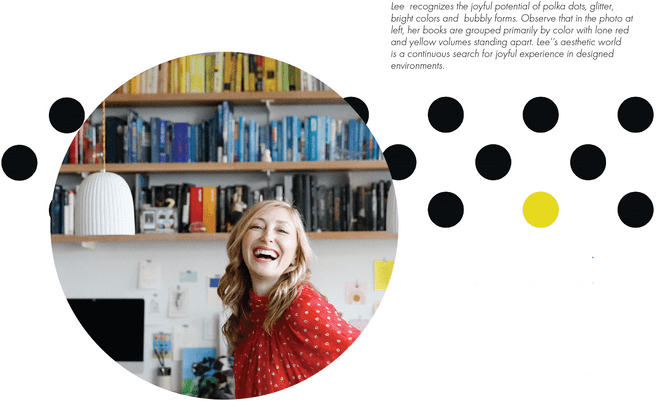
Delivering the Bare Minimum
Retailers’ mission statements are more likely to emphasize the creation of satisfied customers rather than joyful customers. Lee thinks this is a mistake. “The difference between joy and happiness,” explained Lee, “is that happiness is a broad evaluation of how we feel about our lives over time. It has to do with how we feel about our work, our sense of meaning and our purpose in life. It’s also affected by the connection with other people and how we feel about our health. Joy is much simpler and more immediate. It’s an intense, momentary experience of positive emotion—fleeting, but repeatable—something that we can feel again and again and again.
“We often overlook joy because it seems small and trivial. But these little moments have a lot of power. Research shows that when shoppers are in a state of joy, they spend more time browsing in stores. They’re more likely to return for a repeat visit and give higher customer satisfaction ratings. People are more productive when in a state of joy, reach more win-win agreements and make better decisions as well.
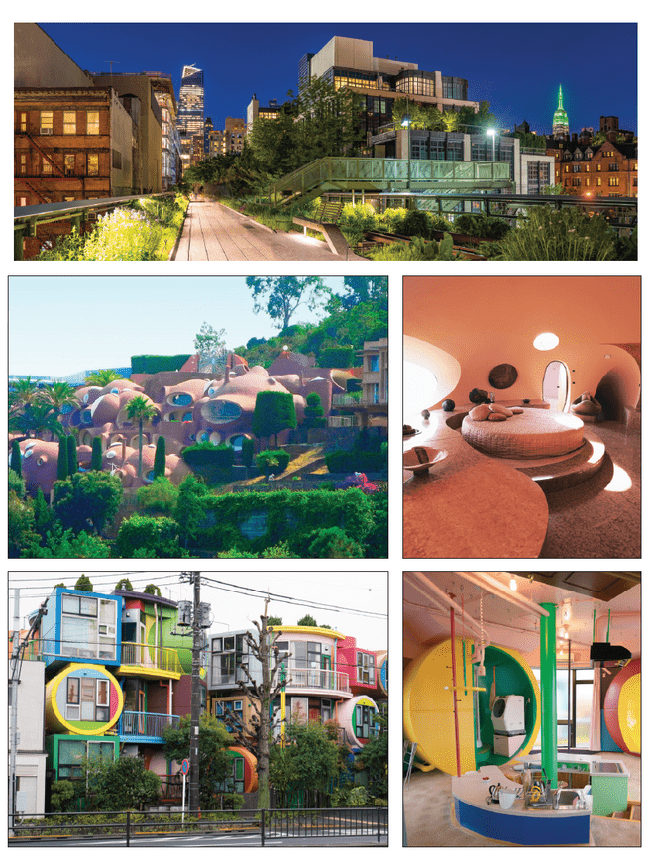
In her search for joyful aesthetics, Lee
visited designer Pierre Cardin’s Le Palais Bulles—the Bubble Palace, with its soft curves and circular forms. She writes, “The shape of our built environment is defined by choices that are hundreds, if not thousands of years old. As these choices solidified our buildings and roads into a rigid, angular grid, they took us further and further from the curving, undulating landscape within which we evolved. Perhaps in the process, they also took us further from essential aspects of our own nature: playfulness, creativity, sensuality, joy.”
Lee takes the reader on tours of many other designed environments including the playful interior or the Destiny Loft (bottom) and New York City’s High Line (top).
|
“Even if happiness is the long-term goal, focusing on little moments of joy can help us get there. Satisfaction is the basic level of just being fine—not unhappy. A satisfied customer is the bare minimum goal for any retailer. If your customers aren’t walking out satisfied, you have a really big problem. It’s hard to design for happiness because it involves so many factors. Everyone has a different definition of it. But everyone can experience little moments of joy.
“When a furniture retailer delivers a satisfying experience, they may just be delivering relief in the face of low expectations. Relief feels joyful if you’re suffering. But if you’re in an industry where delivering relief is what you’re doing most of the time, then there’s something fundamentally broken about that industry. It’s not a good position for any retailer to be in. If the primary emotion that people feel coming out of your store is relief, it signals a major unmet opportunity and an invitation for someone else to deliver a more joyful experience.”
Value of Anticipation
“Anticipation is an important part of joy. Research shows that when we have something to anticipate, we get more joy out of an experience. If someone plans a vacation six months ahead of time, they are likely to get more total joy because they get to pre-enjoy the vacation. Contrary to popular belief, anticipation doesn’t make us feel let down when the experience happens.
“For furniture businesses, creating anticipation is a strategy that’s under leveraged. During COVID, items are backlogged so it’s a perfect opportunity to encourage customers to eagerly anticipate the delivery of their goods. There are ways to keep people excited by helping them to dream, envision and plan to enjoy. Focus on getting people excited about how they are going to use the item they are waiting for. What is the first meal they’re going to cook and serve on their new dining table when it arrives? Who are they going to invite over to help them enjoy it? It’s an outward-looking messaging approach instead of applying inward-looking communications that focus exclusively on manufacturing and delivery updates.”
Selling Good Taste & Trend
Transitioning to the topic of good taste, Lee explained her view that “it is a form of judgment that tends to inhibit joy. That’s because it turns our focus to what other people think instead of what feels good. In the absence of this judgment, people stop thinking about good taste. This sets them free to find things that bring them joy.
“The early work of many famous pioneering designers was considered slightly tacky. But when they moved into the mainstream, their designs became the vanguard of good taste. Taste is fickle. Joy should be eternal.
“Trends, however, can be fun, especially when approached from a sustainability perspective. For that reason, I’m a fan of buying trendy, short lifespan items such as hand towels as opposed to trendy furniture items.”
The Role of Bravery
“To embrace joy in any circumstance takes bravery,” Lee continued. “That’s especially true for someone who has been judged for it in the past. One way to encourage bravery is to model it by displaying pairings that feel unconventional and permit people to be brave. Jonathan Adler is good at giving permission to shoppers to follow what they love. David Hicks said ‘Colors don’t clash, they vibrate.’ It’s a statement that can serve to reset the mind. Shoppers are under pressure to make the right choice, but there’s an opportunity for furniture retailers to make visitors feel like they’ve been set free to choose what they really love.
“Customers may have unmet desires for their home environments, but don’t believe that they have the decorating talent to pursue them. So, they may fall back on comfortable, safe patterns so they don’t make a mistake.”
Lee said that breaking through to help customers overcome this tendency can be a challenge. “It’s hard to tell if there is some unmet desire you can help them move toward or if they are actually on the right track. There are many kinds of dissatisfactions. These vary depending on the personality of the shopper and their motivations for creating a home environment. Some people are motivated to make other people feel welcome and comfortable. Their purchasing choices are rooted in that predisposition. If you can help them make other people feel more comfortable, they’re going to be excited and loyal forever. Other people are free spirits who buy what they love on impulse. Then, when they get everything home, nothing goes together. There are simple tools to help a free spirit understand how to choose colors, but that involves getting more information so they can make better choices while still honoring their impulses.
“There is a design personalities quiz on the aestheticsofjoy.com website Furniture World readers can use to discover their design personality. We have plans to come out with related training and eventually a toolkit.”
Conclusion
“Joyful: The Surprising Power of Ordinary Things to Create Extraordinary Happiness” takes a deep dive into the ways aesthetics affect our psyches.
Shopping for home furnishings can be a bland and predictable experience. Many stores carry similar styles, angular designs in tones of blue, beige and gray. Retailers work to implement systems that double down on bestsellers to maximize important retail sales and operations metrics. Their ads scream the lowest prices, easy financing and the promise of a beautiful home. Advertising data collection is used to find individuals and family groups who are ready to buy, track where they shop and deliver customized messaging. These are all highly successful strategies retailers use to boost sales and deliver customer satisfaction.
So, why should retailers care about the aesthetics of joy? It’s because, as Lee points out, aesthetics matter. Early in “Joyful,” she presents research on the flip side of joyful aesthetics. Incorporating elements of color, light, curves and nature into prisons, schools and offices has been shown to change attitudes and behaviors in dramatically positive ways. Most everyone is familiar with the feeling that typical hospital aesthetics invoke. The poorly lit, claustrophobic, square corners and sterile pigmentation can feel hopeless, bereft of the aesthetics of energy, abundance, freedom, harmony, play, surprise, transcendence, magic, celebration and renewal.
Shoppers are under
pressure to make the
right choice, but there’s
an opportunity for furniture retailers to make visitors
feel like they’ve been set free to choose what they really love. |
Most furniture stores have little in common with the worst aesthetics found in prisons or hospitals. But, for many, there’s room for improvement. Furniture World readers interested in nudging their operations in the direction of joy will find that reading “Joyful” is a good place to start.
Like Ingrid Fetell Lee, you may be inspired to spread the word about how a focus on joyful aesthetics can change people’s lives for the better. And, if you are successful, your stores will create more smiles while increasing customer loyalty, close rates, and average sales.
Lee wrote, “‘Each of us is an artist,’ the Irish philosopher John O’Donohue once said, because ‘everyone is involved, whether they like it or not, in the construction of their world.’ ...we’ve seen how people from a wide range of different backgrounds are doing just this. With paint and markers, yarn and flowers, they are constructing a more joyful world. Now it’s your turn.”
Russell Bienenstock is Editor-in-Chief of Furniture World Magazine, founded 1870. Comments can be directed to him at editor@furninfo.com.